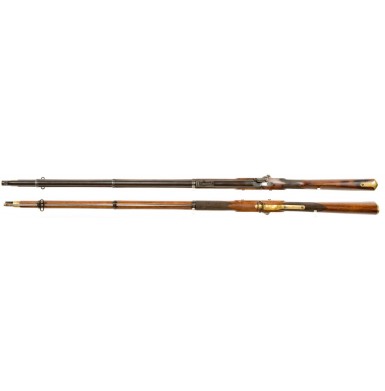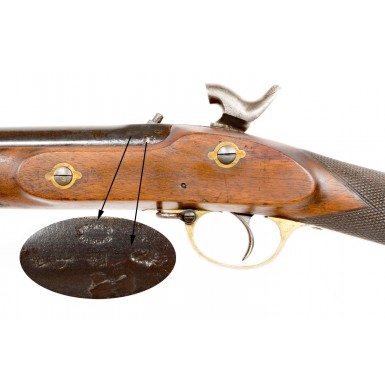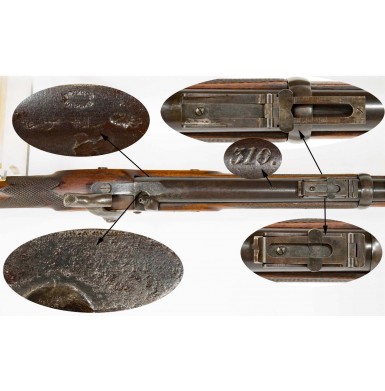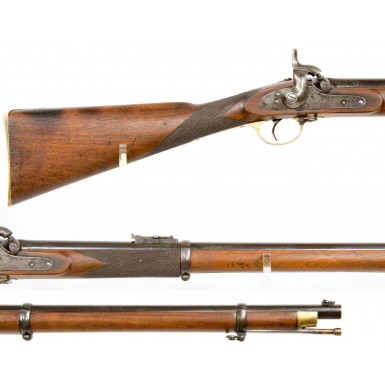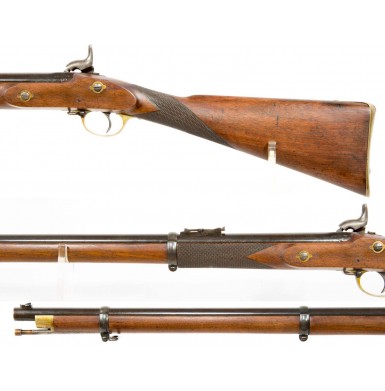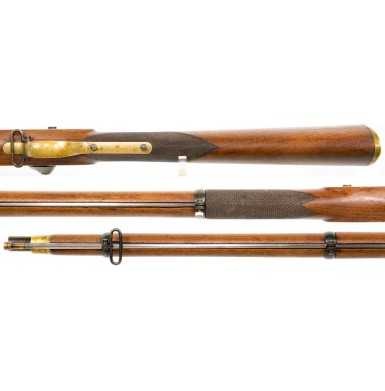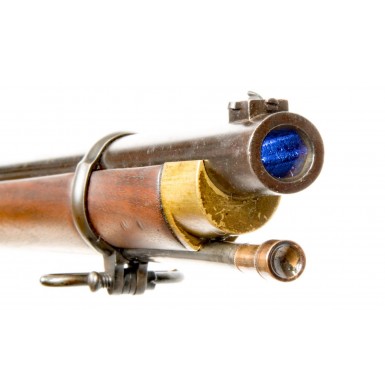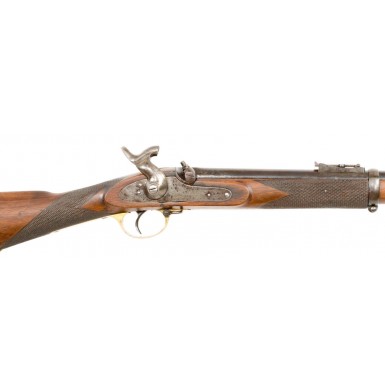Brass Mounted Kerr Rifle Dated 1861 - Rare
- Product Code: FLA-3560-SOLD
- Availability: Out Of Stock
-
$1.00
The Kerr Rifle was designed circa 1860-1861 by James Kerr, who at that time was serving as the superintendent of the London Armoury Company, a position formerly held by Robert Adams of Adams revolver fame. On May 10, 1861 Kerr received English Patent #4348 (1861) for his unique rifling design. The small bore, .451 rifle had a 6-groove, 37” barrel that was slightly recessed at the muzzle to protect the rifling and to facilitate the loading of the paper cartridge. The overall length of the rifle was 53”, and it was stocked to within 1 ¼” of the muzzle, with no provision to mount a bayonet. All of the guns were produced by the London Armoury Company, and it is believed that only about 800 of the guns were manufactured between 1861 and the cessation of London Armoury Company operations in 1866. However, to date I am not aware of any Kerr Rifles with dates later than 1864 on their locks.
For all practical purposes, the gun was a standard London Armoury Pattern 1853 Enfield Rifle Musket, with an upgraded barrel and in some cases upgraded sights. The barrel could be easily exchanged for a standard 39” long .577 caliber barrel for those who wanted a dual caliber rifle. In fact, the earliest production Kerr rifles were marked that they were “fully interchangeable” with the London Armoury Pattern 1853 rifle muskets. This was an important feature for the military target rifle shooters in England, who often competed in matches that required a standard military pattern rifle in .577 caliber, but who also competed in classes that allowed for small-bore rifles. The interchangeability and swappable barrels made the Kerr Small-bore Military Target Rifle a popular choice for those competitive shooters. The rifle was also one of the most accurate designs available during the early 1860s, challenged in its accuracy only by the Whitworth patent rifle, which sold for substantially more money. From an economic standpoint, a Kerr rifle cost roughly twice what a standard Patten 1853 Enfield rifle musket did, but a Whitworth could cost as much as 20 times more than a Kerr Rifle!
The Kerr Rifle was typically equipped with an upgraded and refined version of the standard “Enfield” type rear sight, and with a windage adjustable front sight. As production of the rifles continued, more expensive and complicated sights were offered as options on the guns, including various tang mounted “peep” sights. Extended trigger spurs, and other target shooting enhancements were also available as special-order features on later production rifles.
The initial production guns were typically standard brass mounted Pattern 1853 London Armoury Enfields, with the Kerr barrel, slightly enhanced sights and a special bronze tipped rammer of appropriate length for the shorter barrel. As production continued, better quality wood was used in the stocks, and checkering of the wrists and forends became more common. Iron mountings were also made available as well. Later guns were more often enhanced with engraved locks, screws and forend tips, and of course a myriad of custom order features were always available, with only the buyer’s pocket book being a limiting factor. As with all London Armoury produced arms, the Kerr Rifle underwent some minor improvements as production continued. The most obvious being the adoptions of the rounded Baddeley Patent barrel bands in the lower and middle positions of the stock. These bands had a small, recessed tension screw that eliminated the possibility of snagging the tension screw from the standard Palmer Patent clamping bands. The Palmer band, however, remained in use in the upper position, where the sling swivel was installed. During the American Civil War era, only those Enfields produced by the London Armoury Company and the Royal Small Arms Factory at Enfield Lock (RSAF) utilized the Baddeley Patent barrel bands.
The extreme accuracy of the rifles, their reasonable price (when compared to Whitworth Rifles) and the strong relationship between the London Armoury Company and the Confederacy would suggest that a large number of these special rifles would have been acquired by the south for use by sharpshooters. While the Confederacy did, in fact acquire some of these special rifles, it seems unlikely that they obtained more than sixty to eighty of them, and documents suggest that only about half that number ever made it into the field.
The only confirmed purchase of Kerr Rifles by the Confederate central government was an order placed with Sinclair, Hamilton & Company in July of 1862 by Caleb Huse. It is important to remember that Archibald Hamilton, the principle in Sinclair, Hamilton & Company was also the Managing Director of the London Armoury Company. The order specifies:
“20 small bore Rifles, best cheq’d stocks, brass mountings”
The rifles cost 108 schillings each, only about 25% more than the 75 schillings that Huse had been paying for London Armoury Pattern 1853 Enfields, complete with bayonets. The 20 Kerr Rifles from this order apparently ran the blockade sometime between the fall of 1862 and the fall of 1863, and were eventually delivered to the Richmond Arsenal, where they remained in store until November of 1863. It is not clear when the rifles were delivered, nor when they left England and when they arrived in the South. On November 16, 1863 Colonel Gorgas of the Confederate Ordnance Department Informed Lt. Colonel Hypolite Oladowski, Chief Ordnance Officer of the Army of Tennessee, that he had ordered the Richmond Arsenal to send 20 Kerr Rifles, complete with ammunition to the Army of Tennessee for the use of their sharpshooters. Lt. Col. Oladowski subsequently transferred 10 of these Kerr rifles to General Patrick R. Cleburne’s Division (Hardee’s Corps) at Tunnel Hill, Georgia on December 23, 1863 at the request of Captain Charles S. Hill, Ordnance Officer. Captain Hill officially confirmed the receipt of these rifles on December 24, 1863, and included a personal note wishing Oladowski “Merry Christmas & Happy New Year”. No further documents have been uncovered relating to the field use of the remaining 10 brass mounted Kerr rifles, although it seems unlikely that these very important rifles and expensive rifle would languish in the Richmond Arsenal unnecessarily, when they certainly could have been put to good use in the field by Confederate marksmen.
An additional group of Kerr Rifles has been documented in Confederate service, and these guns also saw service in the Western Theater with the Army of Tennessee. The group of 11 guns were a gift to General John Breckenridge from an unidentified “English Friend”. Breckenridge had formerly commanded the Kentucky “Orphan Brigade”, and he passed the guns directly to his old brigade. In April of 1864, a shooting contest was held by the brigade in Dalton, GA, and the two best shots from the 2nd, 4th, 5th, 6th and 9th Kentucky Infantry were issued these special rifles, with the 11th gun going to Lieutenant George Hector Burton who was placed in command of this elite sharpshooting unit. The Orphan Brigade was officially the 4th Brigade, First Division of General Hardee’s Corps at that time, so all documented issues of Kerr Rifles were to elements of Hardee’s Command. One example of an iron mounted Kerr rifle in a private collection has strong Confederate provenance and is likely one of the 11 Breckenridge guns. Additionally, Claude Fuller & Richard Steuart illustrate an 1863 dated, iron mounted Kerr rifle in their seminal work Firearms of the Confederacy (Plate XXVII, #2. Described on page 230). This gun has provenance of being taken from a Confederate sharpshooter at the battle of Resaca, GA (May 13-15, 1864), but the serial number is not given in the text. This would have been the first major engagement the Breckenridge guns would have seen action in. Another iron mounted, 1863 dated Kerr rifle with Confederate provenance (serial #557) is in the old Battle Abbey (Richmond, VA) collection, which is now known at the Virginia Historical Society. As a number of the items from Richard Steuart’s collection are now in this institution’s collection, it is likely that the Kerr rifle illustrated in Firearms of the Confederacy is the same gun. Based upon the circumstantial evidence supplied by the history and provenance associated with extant rifles, it appears likely that the Breckenridge rifles were iron mounted, while the Huse purchased guns were brass mounted. In June of 1864, Lt. Col. Oladowski submitted an Armament and Ammunition Report of the Army of Tennessee for the week ending on June 25. In the report, he noted : 29 “.44 calibre” rifles. Whitworth Rifles are noted separately in this same report, which suggests that these 29 rifles were in fact Kerr Patent Rifles, the 10 sent to Cleburne at Tunnel Hill, the 11 given to the Orphan Brigade and 8 others, which may have been part of the additional 10 rifles left in storage in Richmond.
In an August 4, 1864 Consolidated Armament and Ammunition Report, sent to Colonel Gorgas from Captain W. D. Humphries, Depot Ordnance Officer, East Point, Georgia, Army of Tennessee he states that:
“We have in this army 38 Whitworth and Kerr’s Rifles which are the same cal. and the Whitworth Cartridge is much preferred of which we have no supply in reserve.”
The report does not, however, specify how many of each rifle were currently in the field.
Additional Kerr rifle purchases are suggested by a report found within the Prize Court records of the United States District Court, Southern District of New York. The report relates to the capture of the blockade-runner Elizabeth. The vessel was captured while attempting to enter Charleston on May 29, 1862. It belonged to John Fraser & Company. Listed within the cargo of the ship were “14 small calibre Enfield Muskets”, which were almost certainly Kerr Rifles. The guns were valued at a paltry $7.00 each, interesting in that US contracts were paying at least double that for regular Enfield rifle muskets. The document further reveals that the rifles were packed in a crate that was marked with a WD within a rhomboid, which almost certainly meant that they were “War Department” (Confederate central government) purchases. However, no corresponding reference to these rifles is found in existing Confederate documents or the Gorgas summary. The crate would have likely contained 20 rifles, as was the standard packing practice for the Enfield rifle muskets. So, it is unclear what happened to the other 6 that should have been in the case.
It appears almost certain that at least a few other Kerr Rifles were acquired by Confederate speculators and were delivered to the Confederacy during the war. The configuration of these guns cannot be determined. However, a reasonable assertion can be made that the Confederate acquired and used Kerr rifles were of “best quality” wood with checkered stocks, standard Kerr patent sights and were delivered with both brass and iron mountings. The presence of enhanced target-shooting features such as tang sights, other specialty sights, pistol gripped stocks or triggerguards, etc. would almost certainly rule out the gun as a candidate for Confederate use. Reasonable deduction reveals that the 20 brass mounted rifles purchased by Caleb Huse would be dated either 1861 or 1862, while the iron mounted Breckenridge guns could be dated as late as 1864, although it seems more likely that they are dated 1862 or 1863. The captured guns from the blockade runner Elizabeth could only bear 1861 or 1862 dates, and it is not clear if these were brass or iron mounted. The reference to those guns as “small calibre Enfields”strongly suggests that they were brass mounted as well. This would indicate that between 34 and 40 brass mounted Kerr rifles, at a minimum, were purchased and imported by the Confederacy. While only 20 can be verified as being delivered to the Confederate Ordnance Department, at least 34 brass mounted Kerr rifles apparently did reach these shores during the war. These brass mounted guns would all have been 1861 or 1862 dated.
Offered here is a NEAR FINE condition example of a scarce and desirable Kerr’s Patent Rifle. The gun is a brass mounted, 1861 dated example that is the prototypical and most documentable version of the Confederate Kerr rifle purchases. The reverse of the butt is marked with the London Armoury Company circular cartouche that reads: LONDON ARMOURY / BERMONDSEY around the date 1861. The lock of the rifle is clearly marked with the usual British (CROWN) / VRto the rear of the hammer, and 1861 / L.A. Co. forward of the hammer. This is one of those “exception to the rule” situations where the presence of the “VR” under the crown does not rule out potential Confederate use. The lock is plain, without engraving or even the boarder lines often found on Kerr Rifles. The very lack of decoration makes it a reasonable candidate for potential Confederate use. The lock has a dull pewter-gray patina, with some mottled areas of darker age discoloration. The lock is mechanically excellent and functions perfectly on all positions. The tumbler incorporates a fly, typical of a high-quality target rifle lock. The interior of the lock is unmarked, other than the bridle, which is marked L.A.C, which is also found on the bridle and interior of the hammer’s neck. The barrel is marked KERR’S PATENT on the top of the nocksform at the breech, but this mark is largely illegible due to light erosive pitting from the percussion cap flash. The left breech of the barrel is marked REG’D / 10 MAY 1861 in a two-line oval cartouche. The left breech also bears the usual London commercial view, proof and definitive proof marks, but without the often found external gauge mark. The serial number of the rifle, 310 is engraved on the top of the barrel, behind the rear sight. The exterior of the barrel is a very attractive combination of flecked traces of original blue and faded plum brown patina, which has blended nicely over most of the exposed surfaces, with a slightly mottled appearance. The barrel retains about 60%+ bright, original blue under the barrel where it has been protected by the stock. There is some light to moderate flash pitting around the breech and bolster area, and this is the only area that shows any significant wear on the barrel. There are a couple of small patches of light surface oxidation present on the barrel, and some lightly scattered pinpricking, but no significant pitting or oxidation is present forward of the breech area. The barrel bands retain strong traces of their original bright blued finish, which shows flaking and has blended to a smooth plum-brown and gray patina as well. The original brass nose cap is in place and it shows none of the decorative engraving more often encountered on the “target grade” rifles. The nose cap shows some discolored traces of what might be old varnish. The brass screw escutcheons that hold the lock screws are plain as well, with no engraving as was often the case on target guns. The triggerguard and buttplate are standard, military pattern brass parts without embellishment. The lack of decoration suggests military, rather than target use for the gun. All of the brass has a nice, mellow golden patina that has a greenish patina. The heads of the triggerguard and buttplate mounting screws are rounded, which is correct for a London Armoury produced long arm, and they retain traces of their blued finish as well. The bore of the rifle is in NEAR FINE condition and is mostly bright but shows some lightly scattered pinpricking and very minor pitting scattered along its length, along with some scattered patches of darker oxidation. The original rear sight, complete with elevator, is in place behind the rearmost barrel band. The sight is correctly indexed on the “bottom” of the ladder, so the graduations face the shooter when the blade is lifted for long range shooting. The sight is complete and fully functional. The original windage adjustable front sight is in place as well, complete with the original tension screw. The original sling swivels are in place on the rifle. Both are military style loop swivels, with one on the upper barrel band lug and the typical swivel on the triggerguard bow. Again, these are features of a military rather than a sporting gun. All three bands are the correct Palmer Patent design, which was the only pattern in use during 1861. All three retain their original doughnut shaped, tension screw protectors. An original and correct, bronze tipped Kerr rifle ramrod is in place in the channel under the barrel. It is full-length and retains crisp threads on its opposing end.
The stock of the rifle is in still relatively sharp and in NEAR FINE condition as well. The stock has been lightly cleaned at some point in time and may have been very lightly sanded. Despite this the stock retains crisp lines and tight wood to metal fit. The stock is crisply and expertly checkered at the wrist and the forend and is very attractive to look at. The quality of the wood is very good, but not visibly better than the wood found on military rifles of the period. This gun was not made with specialty, high quality wood like a target rifle, but with standard grade wood for a working rifle. The entire rifle shows the most wonderful combination of assembly line precision and old world, handmade craftsmanship. The stock does show a handful of minor bumps, dings and small mars, and the checkering shows some light wear. The cartouche on the reverse of the stock is slightly light as well but remains completely legible. The stock shows no abuse or damage, just the wear that is the result of real world carry and use. There is one small grain crack in the stock, running from the rear lock bolt to the barrel channel. This is very small, very minor and completely stable. Most Kerr Rifles have a small German silver escutcheon set into the wrist of the stock for the owner’s initials. This gun does not have this feature, again a suggestion of military, rather than target use.
Overall, this is a really wonderful example of an 1861 dated, brass mounted Kerr’s Patent Rifle by the famous London Armoury Company; one of the most important suppliers or arms to the southern Confederacy. The rifle is in very nice condition, but shows real world use and substantial firing, along with diligent care for its condition and functionality. The flash pitting around the breech and bolster area suggest a significant number of shots were fired by this rifle, but all the while the gun was well cared for. While there is certainly no way to prove that this is one of the Confederate used Kerr Rifles, its simple, military pattern configuration suggests it certainly could have been. The brass mounted best quality rifle with a checkered stock and absent any special target shooting features, combined with military rather than sporting swivels, suggest it could well have been one of the 20 guns purchased through Sinclair, Hamilton & Company or one of the guns captured from the blockade runner Elizabeth. In 2009, a mid-grade Kerr Rifle that was nowhere near as fine as this one sold at James D. Julia’s Auction for $12,000. This rifle is tremendously better than one sold by Julia’s some 10-years ago and is priced only slightly higher. A couple of years ago I had the opportunity to sell a slightly higher condition example of an iron mounted Kerr rifle, dated 1862 in the $16,000 range. Only a handful of Kerr Rifles have sold or traded over the past 20 years, and very few could have potentially had any Confederate association due to their target rifle configurations. This is a fantastic opportunity to obtain an example of one of the most coveted Confederate sharpshooting rifles at a very reasonable price, and about 1/9th the price of a potentially Confederate Whitworth Rifle. With only 800 manufactured, and with few surviving examples, I don’t know when another brass mounted 1861 dated Kerr Rifle (particularly of this quality) will surface again. So, don’t miss your chance for a great Kerr Rifle that may well have been carried by the Confederate snipers of the Army of Tennessee.
SOLD




